佛跳墙英文介绍(包括做法)-完整版
- 格式:pdf
- 大小:1.19 MB
- 文档页数:10

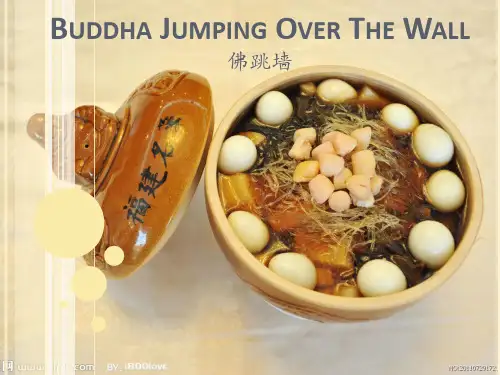

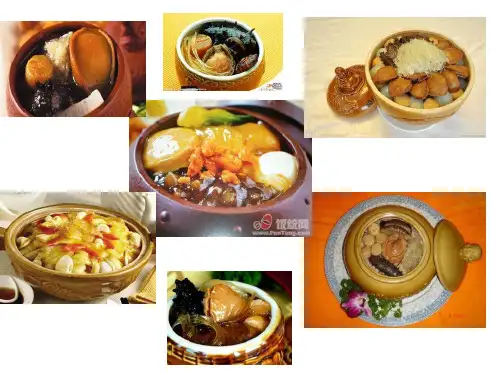
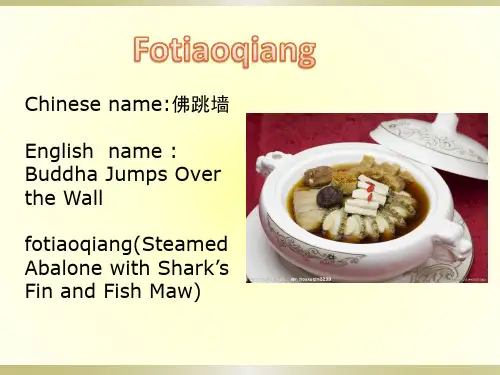

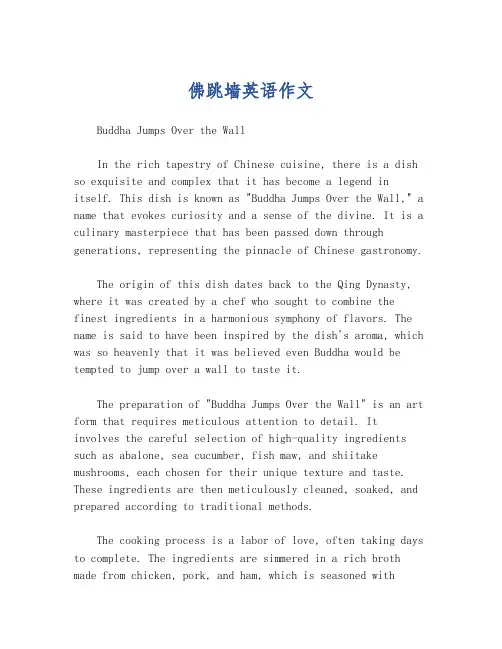
佛跳墙英语作文Buddha Jumps Over the WallIn the rich tapestry of Chinese cuisine, there is a dish so exquisite and complex that it has become a legend in itself. This dish is known as "Buddha Jumps Over the Wall," a name that evokes curiosity and a sense of the divine. It is a culinary masterpiece that has been passed down through generations, representing the pinnacle of Chinese gastronomy.The origin of this dish dates back to the Qing Dynasty, where it was created by a chef who sought to combine the finest ingredients in a harmonious symphony of flavors. The name is said to have been inspired by the dish's aroma, which was so heavenly that it was believed even Buddha would be tempted to jump over a wall to taste it.The preparation of "Buddha Jumps Over the Wall" is an art form that requires meticulous attention to detail. It involves the careful selection of high-quality ingredients such as abalone, sea cucumber, fish maw, and shiitake mushrooms, each chosen for their unique texture and taste. These ingredients are then meticulously cleaned, soaked, and prepared according to traditional methods.The cooking process is a labor of love, often taking days to complete. The ingredients are simmered in a rich broth made from chicken, pork, and ham, which is seasoned withtraditional Chinese spices and aromatics. The dish is then slow-cooked to allow the flavors to meld together, creating a depth of taste that is both luxurious and comforting.Serving "Buddha Jumps Over the Wall" is an experiencethat engages all the senses. The dish is presented in a traditional clay pot, allowing the steam to rise and carry the fragrance throughout the room. The first bite reveals a rich, velvety broth that coats the mouth with a symphony of flavors. Each ingredient retains its distinct texture, yet they come together in a harmonious blend that is both satisfying and invigorating.This dish is not just a meal; it is a journey through the rich history and culture of China. It is a testament to the ingenuity and creativity of Chinese chefs, who have been able to capture the essence of their culinary heritage in a single pot. "Buddha Jumps Over the Wall" is a dish that transcends time and space, offering a glimpse into the heart of Chinese cuisine and the soul of its people.。

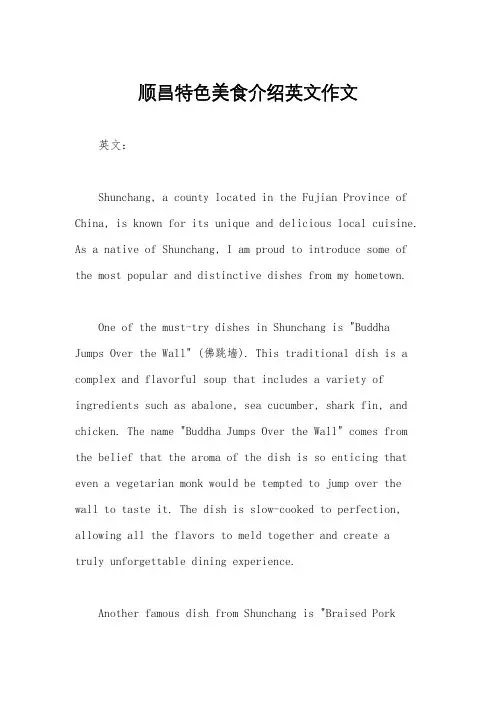
顺昌特色美食介绍英文作文英文:Shunchang, a county located in the Fujian Province of China, is known for its unique and delicious local cuisine. As a native of Shunchang, I am proud to introduce some of the most popular and distinctive dishes from my hometown.One of the must-try dishes in Shunchang is "Buddha Jumps Over the Wall" (佛跳墙). This traditional dish is a complex and flavorful soup that includes a variety of ingredients such as abalone, sea cucumber, shark fin, and chicken. The name "Buddha Jumps Over the Wall" comes from the belief that the aroma of the dish is so enticing that even a vegetarian monk would be tempted to jump over the wall to taste it. The dish is slow-cooked to perfection, allowing all the flavors to meld together and create atruly unforgettable dining experience.Another famous dish from Shunchang is "Braised Porkwith Preserved Vegetables" (梅菜扣肉). This dish features tender pork belly that has been marinated and braised with preserved mustard greens, resulting in a rich and savory flavor. The pork is succulent and melts in your mouth, while the preserved vegetables add a unique tangy and slightly sweet taste to the dish. It's a comforting and satisfying dish that is often enjoyed during family gatherings and special occasions.In addition to these savory dishes, Shunchang is also known for its delectable snacks and desserts. "Fried Oyster Omelette" (蚝烙) is a popular street food that consists of a crispy omelette filled with plump and juicy oysters, and is often enjoyed with a spicy and tangy dipping sauce. Another favorite snack is "Sweet Potato Balls" (地瓜圆), which are small, deep-fried balls made from sweet potato and coated in sesame seeds, resulting in a crunchy exterior and a soft, sweet interior.中文:作为福建省顺昌县的本地人,我很自豪地介绍一些我家乡最受欢迎和独特的美食。

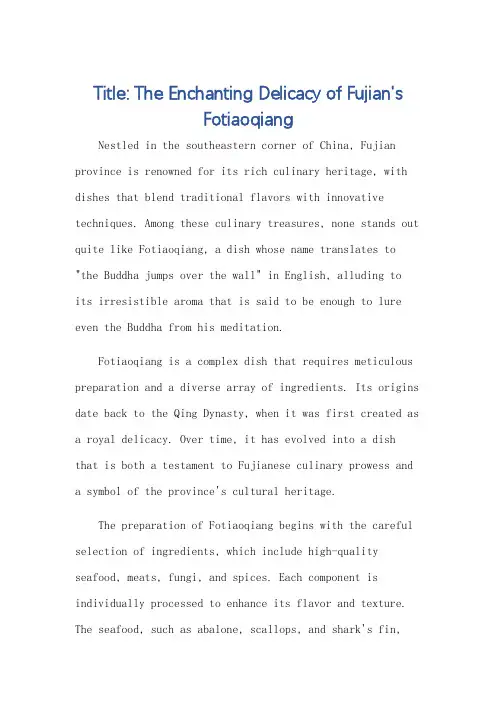
Title: The Enchanting Delicacy of Fujian'sFotiaoqiangNestled in the southeastern corner of China, Fujian province is renowned for its rich culinary heritage, with dishes that blend traditional flavors with innovative techniques. Among these culinary treasures, none stands out quite like Fotiaoqiang, a dish whose name translates to "the Buddha jumps over the wall" in English, alluding toits irresistible aroma that is said to be enough to lure even the Buddha from his meditation.Fotiaoqiang is a complex dish that requires meticulous preparation and a diverse array of ingredients. Its origins date back to the Qing Dynasty, when it was first created as a royal delicacy. Over time, it has evolved into a dishthat is both a testament to Fujianese culinary prowess and a symbol of the province's cultural heritage.The preparation of Fotiaoqiang begins with the careful selection of ingredients, which include high-quality seafood, meats, fungi, and spices. Each component is individually processed to enhance its flavor and texture. The seafood, such as abalone, scallops, and shark's fin,are often soaked in wine to infuse them with a rich, mellow taste. The meats, like duck and chicken, are boiled to tender perfection. Fungi and vegetables add a depth of flavor and texture to the dish.Once the ingredients are ready, they are combined in a large earthenware pot and slowly simmered in a broth made from chicken, duck, and pork bones. This slow-cooking process, often lasting for hours, allows the flavors to meld together, creating a rich and complex taste that is both savory and sweet.The final touch is the sealing of the pot, which traps the steam and aroma inside, intensifying the flavors. When the pot is finally opened, the aroma of Fotiaoqiang istruly captivating, with its sweet and savory scent wafting through the air. The dish itself is a visual masterpiece, with its vibrant colors and array of ingredients.In modern times, Fotiaoqiang has become a prized delicacy not only in Fujian but also throughout China and beyond. Its popularity has led to various interpretations and innovations, but the essence of the dish remains thesame - a harmonious blend of flavors and textures that is both satisfying and delightful.Fotiaoqiang is not just a dish; it is a cultural icon that represents the best of Fujianese cuisine. It is a testament to the province's rich culinary history and a testament to the skill and dedication of its chefs. Whether enjoyed as a special occasion dish or as a culinary adventure, Fotiaoqiang is sure to leave a lasting impression on any food lover.**福建佛跳墙的魅力**位于中国东南角的福建省,以其丰富的烹饪传统而闻名,这里的菜肴既融合了传统风味,又不断创新。
英语作文介绍厦门美食特产英文回答:Xiamen, a coastal city in southeastern China, is renowned for its rich and diverse culinary scene. Thecity's unique geographical location, blending coastal and mountainous influences, has created a culinary tapestrythat tantalizes the taste buds and showcases the region's abundant seafood, fresh produce, and aromatic spices.One of Xiamen's most iconic dishes is Buddha Jumps Over the Wall (佛跳墙, fótiàoqiáng). This luxurious soup, featuring a cornucopia of ingredients such as abalone, sea cucumber, shark fin, and pork belly, is said to have originated in the Qing dynasty and is often served at special occasions.Another must-try Xiamen delicacy is oyster omelet (蚝仔煎, háozǐjiān). Fresh oysters are combined with eggs, flour, and vegetables to create a crispy and flavorfulpancake that is a staple of local street food stalls.No visit to Xiamen would be complete without savoring the city's famous noodles. Shallot noodles (葱油面,cōngyóumiàn) are a simple yet delicious dish made with wheat noodles tossed in a fragrant sauce made from shallots, soy sauce, and pork fat. Other popular noodle dishesinclude fried noodles (炒面, chǎomiàn) and oyster noodles (蚝仔面, háozǐmiàn).Xiamen is also home to a wide variety of seafood dishes. Steamed fish (清蒸鱼, qīngzhēngyú), stir-fried clams (炒蛏子, chǎochēngzi), and braised abalone (红烧鲍鱼,hóngshāobàoyú) are just a few examples of thedelectable seafood offerings available in the city.In addition to its savory dishes, Xiamen boasts a sweet tooth with a range of delectable desserts. One of the most popular is peanut candy (花生酥, huāshēngsū), a crunchy and sweet treat made from peanuts, sugar, and sesame seeds. Other local favorites include pineapple cakes (凤梨酥,fènglísū) and sesame balls (芝麻球, zhīmaqiú).中文回答:厦门,一个位于中国东南沿海的城市,以其丰富多样的美食场景而闻名。